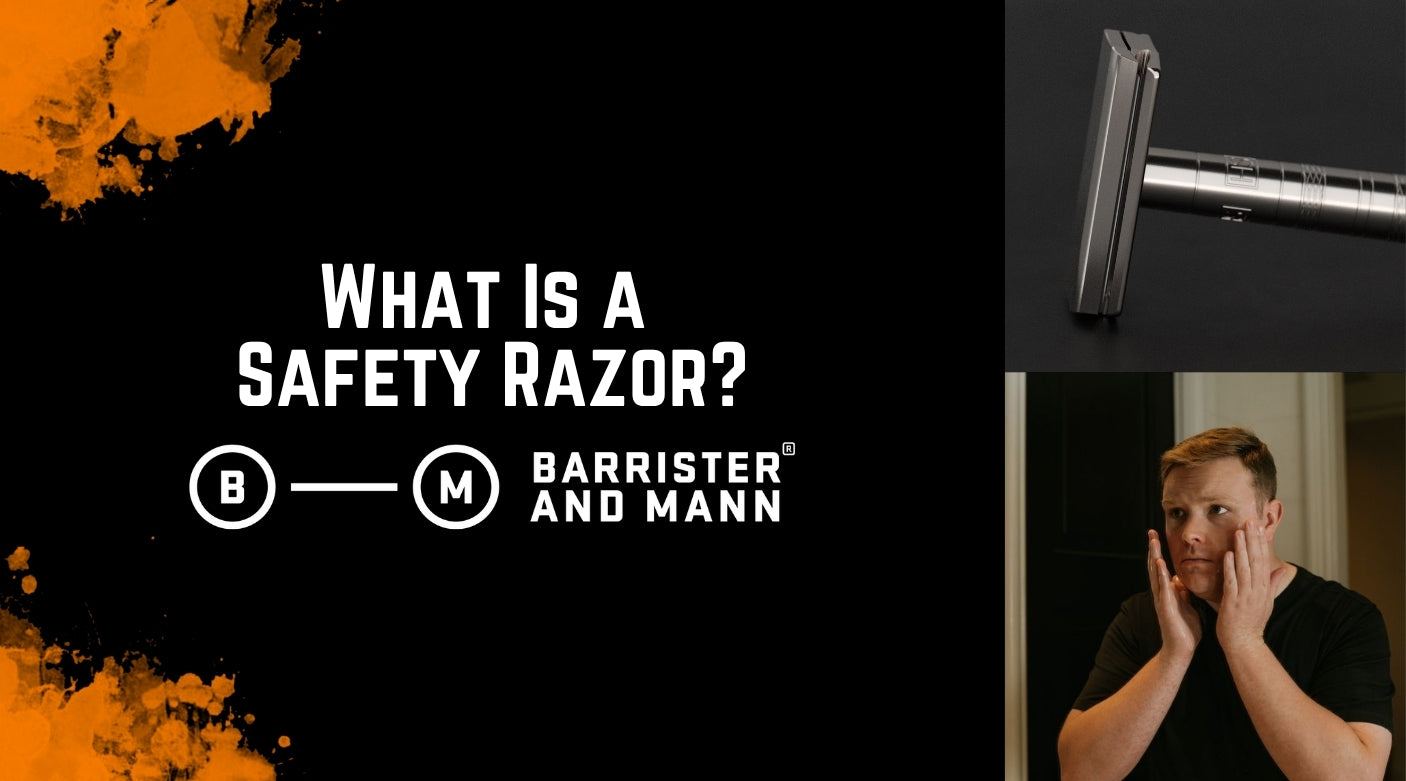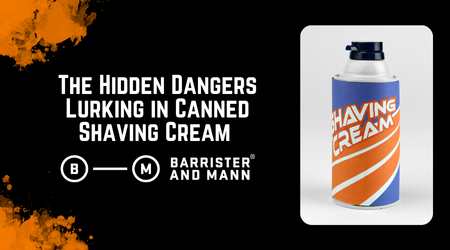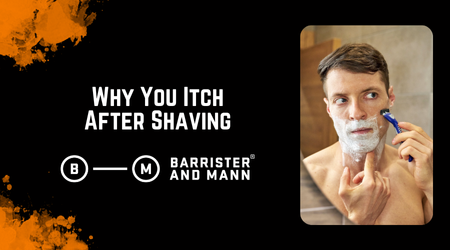A safety razor is a traditional tool that holds a single, replaceable blade—either single-edge or double-edge, to deliver a closer shave, less irritation, and more control than modern razors.
-
A safety razor uses a single exposed blade: A safety razor uses a single exposed blade. It might be a double-edge with two usable sides or a single-edge with one cutting surface, but the principle remains the same: fewer blades mean more control. Traditional wet shaving relies on multiple gentle passes, each one following a specific direction based on the grain of your beard.
-
It skips the plastic and pivoting nonsense: No lubricating strips. No neon green moisture bars. Just metal, precision, and gravity. That simplicity gives you complete control over your shave.
-
It is better for your skin: Less friction, less clogging, and fewer ingrown hairs. Disposable razors strip your skin with every pass. Safety razors do not.
-
It was never really about safety—it was about control: The name comes from the guard that keeps the blade at a fixed angle. The result is a tool that lets you shave properly, not quickly.
-
They have been around for over 100 years for a reason: When something works this well, you do not throw it out. You keep it, you refine it, and you build a ritual around it.
-
They are safer in the long run: Once you stop pressing and start letting the blade do the work, your skin will thank you.
Want to know why this relic still beats everything on the market? Let’s get into it.
The Safety Razor, Defined

A safety razor is a mechanical tool built to hold a single sharp blade. It has three parts: a handle, a head, and the blade itself. The handle connects to the head. The head clamps the blade between two metal plates. That is it. No batteries. No flexing plastic. Just steel and geometry.
The blade is exposed at a fixed angle, protected by a safety bar. This bar prevents too much skin from meeting the blade at once.
Why It’s Called a Safety Razor
Before safety razors, men used straight razors. Think barbershop blades. Big, flat, razor sharp, and unforgiving.
The safety razor introduced a guard that limited how much of the blade could touch your skin. You still had to learn how to use it, but it was a huge improvement in safety and comfort. Hence the name.
This was not a marketing gimmick; it was a genuine upgrade. A tool designed to make a skilled shave accessible at home.
How It Differs From Modern Razors

The razors you will find in most people’s bathrooms have cartridges filled with three, four, even five blades stacked together. They pivot. They clog. They press. They promise speed but deliver irritation. When they disappoint, the companies that make them just add another blade or two and call it innovation.
A safety razor makes one precise cut at a time. There’s no pivoting head, no lubricating strip, and no rubber fins pretending to improve your shave.
What Does Double-Edge Mean?
Double-edge—or DE—refers to the design of the blade itself. A DE blade has two sharpened sides, both exposed by the razor head. You shave with one side, flip it, and keep going with the other; a single blade with two edges. It is simple, efficient, and reduces how often you need to rinse or swap. These are the most common safety razors available today.
Single-edge razors exist too. They expose just one cutting edge at a time. Some are vintage. Some are modern. Both styles work. It just depends on how you like to shave.
The History of the Safety Razor
The idea of putting a protective barrier between blade and skin goes back to the 18th century. A Frenchman named Jean-Jacques Perret is usually credited with the first version of a safety razor. His design was a wooden guard wrapped around a straight razor. It barely worked, but it set the stage.
Then came 1901. King Camp Gillette formed the American Safety Razor Company and patented a razor that used a thin, disposable blade clamped between two metal plates. No stropping, no honing, just shave and replace. It was a revolution: shaving became something you could do at home, not just in a barbershop.
Blades, Simplified
Gillette’s big innovation was the disposable blade. It was cheap to make, easy to swap, and sharp enough to do the job. Millions of men adopted it almost overnight. Other companies followed. The double-edge safety razor became a standard piece of kit, and during World War I, the U.S. military issued them to soldiers by the thousands.
Before the war, shaving was not universal, and beards were common in the ranks. But then came chlorine gas. Then mustard gas. Gas masks required a clean seal and facial hair got in the way, so shaving became mandatory. And when those soldiers returned home, they brought the habit with them. The safety razor became a fixture in every bathroom drawer for decades.
What Happened Next?
Not much changed for decades, but then the 1970s and plastic mania hit. Cartridges arrived, bringing multi-bladed, pivoting heads made from the new all-star material. The idea was convenience and safety a way to avoid handling loose blades. Just snap and go. It worked, sort of.
However, it came with downsides, including more skin irritation, a closer shave that often felt harsher, higher costs, and significantly more plastic waste.
Why Did Safety Razors Fall Out of Fashion?
Cartridges weren’t adopted because they were better. They were adopted because Gillette’s original patents were expiring. The safety razor had become universal; any double-edge blade could fit any razor. So Gillette pivoted. They introduced proprietary cartridge systems that locked customers into a specific handle, creating a built-in market for refills.
It is always easier to sell something dressed up as innovative tech. People assume new means better. Add some plastic. Call it a system. Raise the price. Repeat.
Why Safety Razors Are Making a Comeback
People are starting to pay attention again. They are tired of overpriced cartridges that tug and burn, tired of the vast amounts of waste that disposable cartridges produce, and tired of subscription traps.
A safety razor solves all of that.
The rise of artisan soap and fragrance brands has helped push people away from the big cosmetic companies and toward smaller ones that care about quality. The internet is partially responsible too. It gave people access to tools and information that used to be buried. You can watch a video to learn a new skill and read reviews about why one product might be superior to another. You can learn to shave like your grandfather did, but better.
Old methods are not just surviving in the information age: they are thriving.
Is a Safety Razor Better for Your Skin?
Yes. By a mile.
The biggest problem with modern razors is the blade count, or, more specifically, the friction caused by the blade count. All those stacked edges drag across the same spot over and over. That irritation builds. You feel it right after the shave, and you feel it again the next morning.
A safety razor fixes that by getting back to basics. It uses a single blade and relies on multiple gentle passes, not brute force. The result is a clean, controlled shave that respects your skin.
Less Friction, Fewer Problems
Every extra blade adds more damage. A DE razor uses one sharp edge to make one clean cut. No tugging, no pressure, and no dragging. That means fewer ingrown hairs, fewer bumps, and a lot less redness.
-
Multi-blades pull and tear: The first blade catches the hair and pulls it upward. The next blades follow behind and cut it while it is stretched above the skin. When the hair lets go, it snaps back beneath the surface. That is how you end up with a sharp tip trapped under the skin.
-
Safety razors cut at the surface: No pulling. No trauma. Just a straight slice at skin level.
Real Lather Changes the Game
DE razors pair best with actual shaving soap, not aerosol cream. Real soap applied with a brush creates a structured, dense lather that cushions the blade and holds each hair in place. That gives you a smoother glide and a cleaner cut.
You do not need fancy ingredients. You need a good brush, hot water, and a soap that actually performs.
It Rinses Clean
Cartridge razors clog fast. Hair and cream jam between the blades. You press harder without realizing it. That is how razor burn starts.
Safety razors do not have that problem. The space between blade and head stays open and the hair washes out easily. And if it clogs? Just unscrew the top and take it apart, rinse, and put it back together. Unbelievably simple, yet not possible to do with “modern innovation.”
You Control the Shave
With a DE razor, you control the angle, the pressure, and the direction. That means you can adjust everything to fit your skin. That is not possible with a cartridge head designed to flex and pivot without your input.
Learning how to shave with a safety razor is not hard. It just requires attention. Shave smarter and your skin will show the difference.
For Acne-Prone Skin
Yes, safety razors can work well with acne. You need to be careful, but in many cases, they’re actually the better choice. Cartridges tend to irritate already sensitive skin. Multiple blades mean multiple points of contact. Each one scrapes over inflammation and increases the chance of reopening healing spots.
A safety razor keeps things simple. One blade. One pass. Less disruption. Less trauma.
Use a mild razor paired with a sharp, clean blade. Take your time. Avoid shaving directly over active breakouts more than once.
Why It’s Called “Safe”
The word “safety” throws people off. It sounds like marketing fluff. But when the safety razor first showed up, it was a massive improvement over the straight razors people had been using for centuries. That little metal guard between blade and skin changed everything.
How the Safety Guard Works
The guard controls how much of the blade touches your skin. It smoothes out the surface, helps guide the angle, and limits how deep the blade can go. That one piece of metal is the reason this razor earned its name.
-
The blade is partially enclosed: Only a small edge makes contact with your skin
-
The guard acts as a guide: It helps keep the blade at a consistent angle
-
You are in control: No flexing head or auto-correcting pivot
But Aren’t They Dangerous?
That’s the myth, yes: they’re too sharp, too exposed, and thus too risky. The truth is the opposite: most cuts happen because of user error, not the blade. And the blade itself is not some exotic weapon. It’s a thin strip of metal held in place by screws.
What really causes nicks is pressure and angle. A safety razor is designed to glide. You do not push, you guide. Let the weight of the razor do the work. That is the entire point.
Most DE razors work best at around a 30-degree angle. Rest the cap against your skin, then tilt the handle until the blade just starts to cut. That is the sweet spot. Once you feel it, it becomes instinct.
-
Too much pressure: The most common beginner mistake
-
Wrong angle: Too shallow and it scrapes. Too steep and it skips
-
Dry skin or no lather: A shortcut that leads straight to razor burn
If you do nick yourself, it is usually small. If you are worried someone will find you on the bathroom floor looking like you had a visit from Sweeney Todd, don’t worry: these are not gaping wounds. They’re the same little scrapes your multiblade razor was already giving you. The difference is, with a bit of time and practice, they’ll stop.
The Ritual: Why People Love Using Them
There is a reason people stick with safety razors once they make the switch. It’s not just the performance, it’s the experience. Slow down, focus, and you can build a routine that’s actually worth your time.
Shaving stops being a chore and instead becomes a ritual. Something you do for yourself, not just to get out the door.
It Forces You to Pay Attention
You cannot zone out with a safety razor. That is the point. You feel the blade, watch your angle, notice your skin. There’s something deeply satisfying about being present in the moment while you do it.
-
You choose your soap and your scent: Not whatever aerosol foam was cheapest
-
You build your lather from scratch: A brush, a bowl, a tub or puck of soap that actually smells like something
-
You learn your face: Where the grain runs. Where you tend to rush. What your skin needs
It is tactile and real. It brings intention back to a routine most people try to finish in under two minutes. And it’s personal. Every piece of your kit says something: the handle you like, the blade that works best for your skin, the scent that turns your bathroom into something more than tile and mirror. Everything.
Better for the Planet
Disposable cartridges are landfill fodder. Plastic heads, vacuum-sealed packs, batteries, all of it gets tossed every couple of weeks.
A safety razor? Solid metal. It’s reusable. It has recyclable blades, which means less packaging and less waste.
-
Blades cost pennies: You can buy a hundred for the price of a single cartridge pack. And they can go in the recycling when they are ready to be replaced.
-
Handles last for decades: Not months
-
No planned obsolescence: It works the same way now as it did in 1901
-
Less plastic, less junk, less regret: You are not throwing away a tiny machine every time you shave
What You’ll Need to Get Started
Getting into safety razors and real wet shaving does not require a shelf full of gear. Just a few high-quality tools. And once you have them, you are set for years.
The Essentials
-
A good razor: Start with a three-piece model. Easy to clean, easy to load, and nothing to break. They are the backbone of traditional shaving for a reason.
-
Quality blades: Try a sampler pack. Brands like Feather, Personna, and others still in production offer a range of sharpness and comfort levels. You'll find one that suits your face and hair.
-
Shaving soap: Skip the canned goop. Real soap builds a dense, slick lather that protects your skin, holds the hair in place, and cushions the blade. It is not optional, but it’s the difference between gliding and dragging.
-
A brush: Synthetic is a great place to start. Less breaking in than boar, it won't break the bank like badger, and it works beautifully. A good brush lifts the hair and builds lather the way your hand never could.
-
A blade disposal plan: Used blades are still sharp, and without the safety bar, they are no longer safe. Do not toss them loose in the trash. A simple tin or dedicated blade bank works perfectly. When it fills up, recycle the whole thing.
Final Thoughts for the Curious Shaver
It takes a little time to get used to. You will probably nick yourself once or twice. You might botch the angle on your first go. That’s fine. That’s how you learn. And the payoff is absolutely worth it.
What You Leave Behind
-
Overpriced cartridges: No more paying a premium for plastic and pivots
-
Skin trauma: No more dragging five blades across your face in one swipe
-
Waste: No more packaging, no more landfill junk
-
The rush: You slow down. You focus. You care
You replace it with something better. Something personal. A shave that actually respects your skin.
The Shave That Changes Everything
Shaving does not have to be annoying, rushed, or painful. Nor does it have to be a subscription or a smart device or whatever someone in a boardroom decided you need next.
It can be simple, satisfying, and straightforward. A sharp blade, a good soap, and a few quiet minutes to take care of yourself are all you really need.
For your skin, your wallet, and your sanity, the safety razor is absolutely worth a look.
Looking to start your own shaving ritual? These are the tools that will get you going.
-
Razors and Blades – We select only the razors and blades we think are worth your time. No gimmicks. Just solid tools that work. Options for every budget, from starter-friendly to heirloom quality.
-
Synthetic Shaving Brush – With a 24mm knot made of exquisitely soft synthetic fiber, these brushes are perfect for any soap in any conditions.
-
Seville – Of course you will need soap to go with your new blade and brush. Our best-selling shaving soap, Seville, is affectionately dubbed “God’s barbershop,” and delivers elite performance and a scent you’ll actually look forward to.


